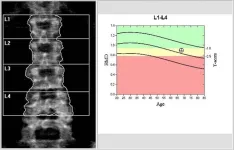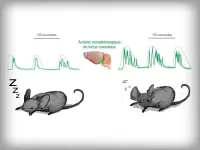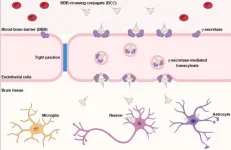(Press-News.org) CHICAGO – Levothyroxine, the second most commonly prescribed medication among older adults in the U.S., may be associated with bone loss, according to a study being presented next week at the annual meeting of the Radiological Society of North America (RSNA).
Levothyroxine, marketed under multiple brand names including Synthroid, is a synthetic version of a hormone called thyroxine and is commonly prescribed to treat the condition hypothyroidism, or underactive thyroid. In people with hypothyroidism, the thyroid gland does not produce enough thyroxine on its own, often resulting in fatigue, weight gain, hair loss and other symptoms. If left untreated, hypothyroidism can lead to serious and potentially fatal complications.
Approximately 23 million Americans—about 7% of the U.S. population—take levothyroxine daily. Sometimes, patients have been taking levothyroxine for many years, but it is not clear why it was initially prescribed or if it is still required.
“Data indicates that a significant proportion of thyroid hormone prescriptions may be given to older adults without hypothyroidism, raising concerns about subsequent relative excess of thyroid hormone even when treatment is targeted to reference range goals,” said the study’s lead author Elena Ghotbi, M.D., postdoctoral research fellow at Johns Hopkins University School of Medicine in Baltimore, Maryland.
Though there are some variables, a normal reference range for thyroid-stimulating hormone (TSH) is typically around 0.4 – 5.0 microunits per milliliter. Excess thyroid hormone has been associated with increased bone fracture risk.
For this study—a multidisciplinary collaboration between the Russell H. Morgan Department of Radiology and Radiological Science and Endocrinology Department at Johns Hopkins Medical Institutions, Dr. Ghotbi and colleagues aimed to determine whether levothyroxine use and higher thyroid hormone levels within the reference range are associated with higher bone loss over time in older “euthyroid” adults, meaning adults with normal thyroid function.
The researchers used the Baltimore Longitudinal Study of Aging (BLSA), a prospective observational cohort study of community-dwelling older adults. Participants aged 65 and older who had at least two visits and thyroid function tests consistently within the reference ranges were included in Dr. Ghotbi’s study.
“This research is a collaboration between Johns Hopkins and the BLSA, the longest-running study on aging conducted by the Intramural Research Program of the National Institute on Aging,” said co-author Eleanor Simonsick, Ph.D., epidemiologist and BLSA co-director. “The BLSA’s extensive data include repeated DEXA measurements at each study visit, which provides valuable insight into the progression of bone density and bone mass changes over time, offering a more comprehensive understanding of aging-related osteoporosis.”
The study group included 81 euthyroid levothyroxine users (32 men, 49 women) and 364 non-users (148 men, 216 women), with a median age of 73 and TSH levels of 2.35 at the initial visit. Other risk factors like age, gender, height, weight, race, medications, smoking history and alcohol use were considered in propensity score matching of levothyroxine users versus non-users.
The results showed that levothyroxine use was associated with greater loss of total body bone mass and bone density—even in participants whose TSH levels were within the normal range—over a median follow-up of 6.3 years. This remained true when taking into account baseline TSH and other risk factors.
“Our study suggests that even when following current guidelines, levothyroxine use appears to be associated with greater bone loss in older adults,” said Shadpour Demehri, M.D., co-senior author and professor of radiology at Johns Hopkins.
Jennifer Mammen, M.D., Ph.D., co-senior author and associate professor of endocrinology at Johns Hopkins, advises that adults taking levothyroxine should discuss their treatment with their health care provider and regularly monitor their thyroid function tests. “A risk-benefit assessment should be conducted, weighing the strength of the indications for treatment against the potential adverse effects of levothyroxine in this population,” she said.
Other co-authors are Hamsa Ibad, M.B.B.S., and Qian-Li Xue, Ph.D.
###
Note: Copies of RSNA 2024 news releases and electronic images will be available online at RSNA.org/press24.
RSNA is an association of radiologists, radiation oncologists, medical physicists and related scientists promoting excellence in patient care and health care delivery through education, research and technologic innovation. The Society is based in Oak Brook, Illinois. (RSNA.org)
For patient-friendly information on DEXA, visit RadiologyInfo.org.
END
CHICAGO – Researchers have identified acute effects of cigarette and e-cigarette smoking on vascular function, even without nicotine. The results of the ongoing research are being presented next week at the annual meeting of the Radiological Society of North America (RSNA).
E-cigarettes, also known as vapes, are battery-operated devices that heat a liquid to produce an aerosol, which is then inhaled into the lungs. Vapes contain significantly fewer chemicals and toxins than are found in tobacco smoke. As a result, e-cigarettes are believed by many to be less harmful than cigarette smoking. Vapes also come in various flavors, making them popular among young people.
“E-cigarettes ...
Researchers at the University of Lausanne have identified a novel role for the brain’s ‘locus coeruleus’ in sleep and its disruptions. This brain region facilitates the transition between NREM and REM sleep states while maintaining an unconscious vigilance toward the external world. Stress disrupts its functions and negatively impacts on sleep quality.
Sleep disorders affect an increasing number of people, with potentially serious consequences for their health. Mammalian sleep consists of cycles between two states: non-rapid eye movement (NREM) sleep and rapid eye ...
New York, NY [November 25, 2024]—Researchers at the Icahn School of Medicine at Mount Sinai have developed an innovative approach—demonstrated in mouse models and isolated human brain tissue—to safely and effectively deliver therapeutics into the brain, providing new possibilities for treating a wide range of neurological and psychiatric diseases.
Published in the November 25 online issue of Nature Biotechnology [https://doi.org/10.1038/s41587-024-02487-7], the study introduces a first-of-its-kind blood-brain barrier-crossing conjugate (BCC) system, designed to overcome the protective barrier that typically blocks large biomolecules from ...
The ancient Vikings certainly had the travel bug. Between the late eighth century and approximately 1050 CE, they roamed the Atlantic in their longships all the way to Newfoundland, Labrador, and Greenland, as well as exploring the Mediterranean and continental Eurasia.
Among the places the Vikings are known to have settled were the Faroe Islands, an archipelago of 18 islands in the North Atlantic. They probably weren’t the first to do so: archaeologists have found evidence that these islands had been inhabited since approximately 300 CE, possibly ...
Affordability in Canada affects not just groceries but also medications, with 1 in 20 people unable to take their medications as prescribed because of cost, found new research published in CMAJ (Canadian Medical Association Journal) https://www.cmaj.ca/lookup/doi/10.1503/cmaj.241024.
Prescription medications are not universally covered under Canada’s 13 provincial and territorial health insurance systems. In 2021, Canadian households paid more than $7.4 billion out of pocket for prescription medications.
The study, which included a nationally representative ...
Remotely operated camera traps, sound recorders and drones are increasingly being used in conservation science to monitor wildlife and natural habitats, and to keep watch on protected natural areas.
But Cambridge researchers studying a forest in northern India have found that the technologies are being deliberately misused by local government and male villagers to keep watch on women without their consent.
Cambridge researcher Dr Trishant Simlai spent 14 months interviewing 270 locals living around the Corbett Tiger Reserve, a national park in northern India, including many women from nearby villages.
His report, published today in the journal Environment and Planning ...
Around 450,000 children are being failed by the UK education system because they have a special educational need and disability (SEND) that is effectively unrecognised by most schools and local education authorities, an author has warned.
Supporting Colour Blindness in Education and Beyond, by author Marie Difolco, shines a spotlight on a commonly-overlooked SEND in modern classrooms: colour blindness (also known as colour vision deficiency, or CVD). She also warns that many myths surround this condition, with many people believing it just means not being able to tell the ...
Osaka, Japan – Smartphone-based augmented reality, in which visual elements are overlaid on the image of a smartphone camera, are extremely popular apps. These apps allow users to see how furniture would look in their house, or navigate maps better, or to play interactive games. The global phenomenon Pokémon GO, which encourages players to catch digital creatures through their phone, is a well-known example.
However, if you want to use augmented reality apps inside a building, prepare to lower your expectations. ...
Study sought to better understand how humans evolved to become skilled at thinking about others
Newer parts of the brain that support social interactions are connected to and in constant communication with the ancient amygdala
First study to map with fMRI never-before-seen details of the brain’s social cognitive network
CHICAGO --- We’ve all been there. Moments after leaving a party, your brain is suddenly filled with intrusive thoughts about what others were thinking. “Did they think I talked too much?” “Did my joke offend them?” “Were ...
Black men on buses and trains — whether as passengers or transit workers — face hostile encounters that threaten their sense of safety and well-being, according to a new study by a Keough School of Global Affairs sociologist. By reinforcing racist tropes that they are dangerous or invisible, these encounters can also erode Black men’s sense of dignity and self-worth.
“Black men who want to go to work, school, appointments, visit others, or do any of the other things that people use public transport for, find the experience to be degrading rather than liberating,” said Gwendolyn Purifoye, assistant professor of racial justice and conflict transformation in ...








